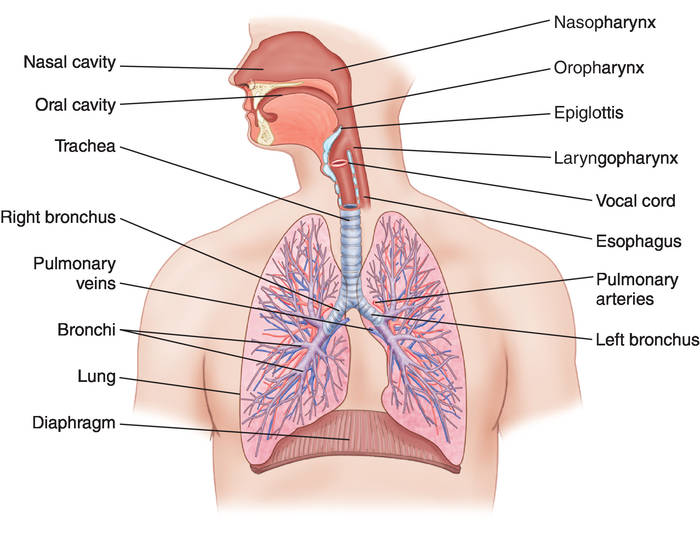I.- WHAT IS THE RESPIRATORY SYSTEM?
The human respiratory system is a series of organs responsible for taking in oxygen and expelling carbon dioxide.
There are different organs involved in the interchange of gases between an organism and the atmosphere:
The human respiratory system is a series of organs responsible for taking in oxygen and expelling carbon dioxide.
II.-PARTS OF THE RESPIRATORY SYSTEM
There are different organs involved in the interchange of gases between an organism and the atmosphere:

- Nose and Nasal Cavity: form the main external opening for the respiratory system and are the first section of the body’s airway—the respiratory tract, through which air moves. It function is to warm, moisturize, and filter air entering the body before it reaches the lungs. Air exiting the body through the nose returns moistured and heated to the nasal cavity before being exhaled out to the environment.
- Mouth: The oral cavity is the secondary external opening for the respiratory tract. The main advantage of breathing through the mouth is that its shorter distance and its larger diameter allow more air to enter quickly in the body.
- Pharynx: Is a muscular funnel that extends from the posterior end of the nasal cavity to the superior end of the esophagus and larynx.
- Larynx: Is a short section of the airway where the human voice is made, by connecting the laryngopharynx and the trachea sounds. The tension and vibration speed of the vocal folds can be changed to change the pitch that they produce.
- Trachea: Connects the larynx to the bronchi and allows air to pass through the neck and into the thorax. The rings of cartilage that make up the trachea allow it to remain open to air at all times. The main function of the trachea is to provide a clear airway for air to enter and exit the lungs.
- Bronchi and Bronchioles: The main function of the bronchi and bronchioles is to carry air from the trachea into the lungs. Smooth muscle tissue in their walls helps to regulate airflow into the lungs.
- Lungs: Are a pair of large, spongy organs found in the thorax lateral to the heart and superior to the diaphragm. The interior of the lungs is made up of spongy tissues containing many capillaries and around 30 million tiny sacs known as alveoli. The alveoli are cup-shaped structures found at the end of the terminal bronchioles and surrounded by capillaries.
- Muscles of Respiration: Surrounding the lungs are sets of muscles that are able to cause air to be inhaled or exhaled from the lungs.
- The principal muscle of respiration in the human body is the diaphragm. When the diaphragm contracts, it moves inferiorly a few centimeters into the abdominal cavity, expanding the space within the thoracic cavity and pulling air into the lungs. Relaxation of the diaphragm allows air to flow back out the lungs during exhalation.
- Between the ribs are many small intercostal muscles that assist the diaphragm with expanding and compressing the lungs.
III.- HOW DOES THE RESPIRATORY SYSTEM WORK
In the respiratory system, the airways are connected to the lungs, muscles and blood vessels. The respiratory system works by breathing in air through the nose or mouth. Abdominal muscles and the diaphragm help the lungs expand and contract when the body needs to inhale or exhale. After inhaling, air passes through the larynx, travels down the windpipe, goes through the bronchial tubes and enters the lungs. From the lungs, oxygen travels to the veins and arteries. When the body exhales, carbon dioxide exits the body through the windpipe and the nose or the mouth.
1. Pulmonary
Ventilation: Is the process of moving air into and out
of the lungs to facilitate gas exchange. The respiratory system uses both a
negative pressure system and the contraction of muscles to achieve pulmonary
ventilation.
2. External
Respiration: is the exchange of gases between the air
filling the alveoli and the blood in the capillaries surrounding the walls of
the alveoli. The net that results of
external respiration is the movement of oxygen from the air into the blood and
the movement of carbon dioxide from the blood into the air. The oxygen can then
be transported to the body’s tissues while carbon dioxide is released into the
atmosphere during exhalation.
3. Internal
Respiration: Is the exchange of gases between the blood
in capillaries and the tissues of the body. The net result of internal respiration
is the diffusion of oxygen into the tissues and the diffusion of carbon dioxide
into the blood.
4. Transportation
of Gases: the two main respiratory gases, oxygen and
carbon dioxide, are transported through the body in the blood. Blood plasma has
the ability to transport some dissolved oxygen and carbon dioxide, but most of
the gases transported in the blood are bonded to transport molecules.
Hemoglobin is an important transport molecule found in red blood cells that
carries almost 99% of the oxygen in the blood. Hemoglobin can also carry a
small amount of carbon dioxide from the tissues back to the lungs.
IV.- FUNCTIONS OF RESPIRATORY SYSTEM
- Supplies the body with oxygen and disposes of carbon dioxide.
- Filters inspired air.
- Produces sound.
- Contains receptors for smell.
- Rids the body of some excess water and heat.
- Help regulate blood pH.
i like your work
ResponderEliminar